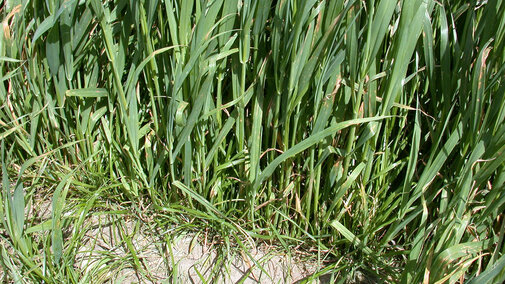Oats and Italian Ryegrass for High Quality Pasture
By Jerry Volesky
Good quality pasture might be in short supply this spring. If you need some spring pasture, plant oats or a mix of oats and Italian ryegrass.
Spring-planted oats grows during spring when we are likely to receive rain and when moisture is used efficiently to produce forage. Oats can be grazed earlier than anything else you plant this spring. Once it gets five or six inches tall, which is usually about the third week of May, it quickly can shoot up to a foot tall in almost no time. Unfortunately, once oats get that tall it may not stool out, tiller and regrow after grazing very well. So it’s important to start grazing early when oats get six to eight inches tall to stimulate it to form new tillers.
After this first grazing, keep oat regrowth between six and 16 inches tall. Begin with a light stocking rate, about one animal every two acres. Then adjust animal numbers as oat growth changes.
For a longer grazing season, plant a mixture of oats and Italian ryegrass. Oat comes on strong early, while Italian ryegrass tends to wait until June before it grows rapidly. Then it just keeps growing high quality leaves the rest of the year if moisture is available.
For straight oats, drill at least two bushels per acre in late March to early April. Oats will be six to eight inches tall and ready to graze in about seven weeks. With good moisture and 40 to 60 pounds of nitrogen, oats can provide a couple months of grazing for one or two cows per acre. For extended grazing, drill oats plus around 15 to 20 pounds of Italian ryegrass per acre. Your stocking rate might need to be a little lighter at first, but with some timely moisture or irrigation you can continue to get great grass all summer and fall.
Grass-Alfalfa Mixtures or Pure Alfalfa?
By Brad Schick
Planting a new alfalfa hay field is a pretty routine undertaking. Have you considered putting some grass in that new planting this year?
Putting a field back into alfalfa is a practice that often goes with little thought of alternative species. Every operation is different, so pure alfalfa may still be the best option. Some producers may want to seed smooth bromegrass, orchardgrass, festulolium or other grasses with the alfalfa. But why consider a mixture?
Many producers roll out bales for winter feeding, while others may grind different hays or feedstuffs. If more than five to six pounds of alfalfa is being fed to brood cows, that may be too little energy or TDN and too much protein. This is with a good quality alfalfa. If an alfalfa-grass hay is fed instead, the protein may be lower, but the TDN will be higher and better meet the energy requirements of those cows while not overfeeding protein. The mixing of the hay is done in the field while it grows instead of with the machinery in the winter.
Not every field is equal; just look at a soil map. Soil types or conditions may vary within a field and a mixture may result in a better overall stand. Alfalfa, for example, doesn’t like “wet feet” so the grass planted will do better in low lying areas where alfalfa can’t survive. Additionally, an alfalfa-grass mix usually dries down more quickly so it can get put up sooner. Typically, a mixture will yield the same or more than pure alfalfa on an annual basis, with most of the grass tonnage produced in the first cutting.
Mixtures do have to be managed differently than pure alfalfa stands, and some buyers may only want alfalfa, but for some operations, a mixture might be the perfect recipe.

